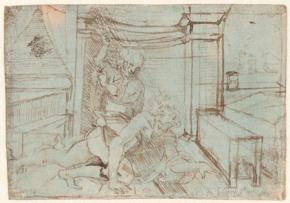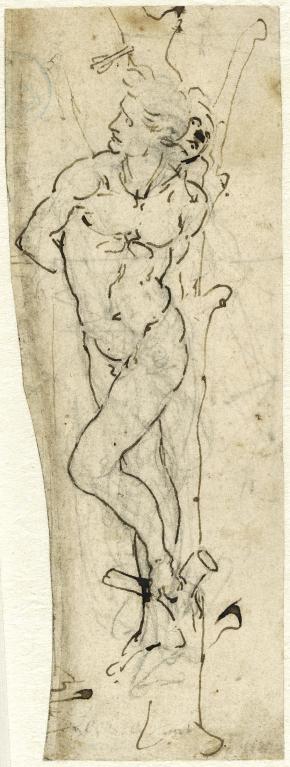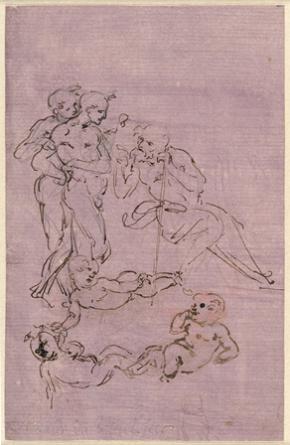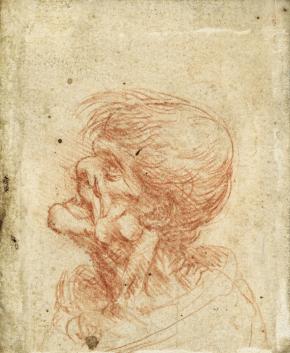Technological Analysis of the Leonardo Drawings
In the process of preparing for this exhibition, these four drawings by Leonardo were able to be examined using art historical technology for the first time. This scientific project was conducted as a cooperation between the Hamburger Kunsthalle and the special research group on Manuscript Cultures in Asia, Africa, and Europe (SFB 950) at the Universität Hamburg. In addition to methods such as transmitted light, grazing light, ultraviolet and infrared illumination, as well as microscopic magnification, these artworks were examined in further detail by means of X-ray fluorescence analysis (XRF) and spectrophotometry (Vis). Sabine Zorn, the Head of Paper and Photograph Conservation at the Hamburger Kunsthalle, working together with Dr. Sebastian Bosch and Prof. Oliver Hahn, was able to gain important new insights into the drawing materials and paper that Leonardo used. For example, it has now become clear that Leonardo used iron gall ink for all of the pen drawings that were examined. A lead-tin stylus was used for the preliminary sketch of »Study for an Adoration of the Shepherds« and charcoal for »St. Sebastian«. The colored ground-layers contain bone white, indigo, and, in the case of the purple-violet ground, a red insect dye called kermes. Under UV and IR illumination, additional lines were found in the »Study for an Adoration of the Shepherds«, which were presumably erased during the course of its production process.
Cat. 1-4 Leonardo da Vinci (1452-1519)
Aristotle and Phyllis, ca. 1475
This drawing of the popular scene known as »The Power of Women Over Men« originated during Leonardo’s early period in the second half of the 15th century. It depicts the moment when the famous Greek philosopher Aristotle (384-324 B.C.) is crawling on the ground, allowing himself to be humiliated by his lover, Phyllis. The great scholar is shown moving from a place of lust to a place of learning, which is truer to his essence. However, his facial expression reveals a sense of ambivalence.

Cat. 1 Leonardo da Vinci (1452–1519)
Aristotle and Phyllis, ca. 1475
Pen in brown ink over metalpoint stylus (?) on blue-green-gray paper; traces of a borderline (pen in brown ink)
Georg Ernst Harzen legacy for the Kunsthalle opening in 1869
Hamburger Kunsthalle, Kupferstichkabinett (Department of Prints and Drawings)
Saint Sebastian, ca. 1478/1483
Leonardo’s study of Saint Sebastian, which was indeed produced during his first Florentine period, surpasses other contemporary depictions of the saint due to its vigorous movements. It vividly illustrates how the artist was exploring with his drawing technique – in this case he was studying a complicated body movement. The precise purpose of the drawing is not entirely clear, but it may have been a preliminary study for a private devotional image or altarpiece.

Cat. 2 Leonardo da Vinci (1452–1519)
Saint Sebastian, ca. 1478/1483
Pen in brown ink over charcoal
Georg Ernst Harzen legacy for the Kunsthalle opening in 1869
Hamburger Kunsthalle, Kupferstichkabinett (Department of Prints and Drawings)
Study for an Adoration of the Shepherds, ca. 1480
Around 1480, Leonardo dealt with compositional studies for an »Adoration of the Shepherds« and an »Adoration of the Magi« intensively. This drawing, which is particularly eye-catching due to its purple-violet ground-layer, illustrates Leonardo’s ability to develop strongly expressive figures and exciting scenery with just a few strokes of the pen. The position of Saint Joseph here is quite unusual, as he is not secluded on the side in quiet contemplation, as was commonly done, but instead he is placed among the group.

Cat. 3.
Leonardo da Vinci (1452–1519)
Study for an Adoration of the Shepherds, ca. 1480
Pen in black ink over lead-tin stylus on paper primed in purple-violet; the sketch of the child (lower-right) was added by the artist’s hand with pen in brown ink
Georg Ernst Harzen legacy for the Kunsthalle opening in 1869, Hamburger Kunsthalle, Kupferstichkabinett (Department of Prints and Drawings)
Head of an Old Man or an Old Woman in Profile, ca. 1495/1505
Leonardo was indeed one of the first artists who systematically put the human physiognomy in all of its facets on paper in his drawings. In doing so, his intention was by no means to portray only beauty and harmony, but rather also the supposedly ugly and deformed. The depiction is dignified and a far cry from those facial studies that are exaggerated to the point where they can be regarded as caricatures, eliciting involuntary smirks from the viewer. This composition was apparently in very high demand, because some of the contours were punctured with a needle for the purpose of transfering them.

Cat. 4 Leonardo da Vinci (1452–1519)
Head of an Old Man or an Old Woman in Profile, ca. 1495/1505
Ruddle (red chalk)
Georg Ernst Harzen legacy for the Kunsthalle opening in 1869
Hamburger Kunsthalle, Kupferstichkabinett (Department of Prints and Drawings)







